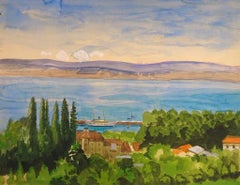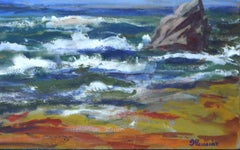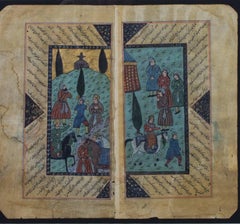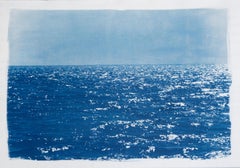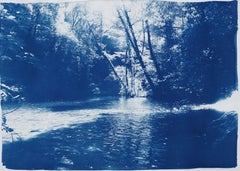Tempera Landscape Prints
to
1
2
Overall Width
to
Overall Height
to
1
1
1
1
2
1
3
2
2
2
1
1
1
1
1
1
1
1
1,355
6,823
3,566
2,655
1,393
1
1
Medium: Tempera
Paysage - Emile Deschler - Tempera
Located in Roma, IT
Paysage is an original tempera by Emile Deschler. Unsigned. Good conditions, except for a rip along the left margin.
Emile Deschler (France, 1910 - 1991) was a French painter. In 19...
Category
20th Century Modern Tempera Landscape Prints
Materials
Tempera
Marine - Original Tempera on Cardboard by Jacques Meunier - Mid 20th century
By Jacques Meunier
Located in Roma, IT
Marine is an original artwork realized by Jacques Meunier. Original tempera on heavy cardboard.
Hand-signed on the lower right corner.
Very good conditions.
The artwork represen...
Category
1950s Tempera Landscape Prints
Materials
Tempera
"Royalty Greeting Townspeople, " a Tempera Diptych from the Late 19th c.
Located in Milwaukee, WI
"Royalty Greeting Townspeople" is a Persian tempera diptych from the Late 19th century. It includes multiple figures in red and blue interacting in a f...
Category
Late 19th Century Other Art Style Tempera Landscape Prints
Materials
Tempera
Related Items
Coastal Blue Cyanotype of Day Time Seascape, Cold Waves, Nautical Painting Shore
By Kind of Cyan
Located in Barcelona, ES
This is an exclusive handprinted limited edition cyanotype.
"Day Time Seascape in Blue" is a handmade cyanotype print portraying the vibrant reflections of the Sun as seen from the c...
Category
2010s Modern Tempera Landscape Prints
Materials
Paper, Watercolor, Lithograph
Romantic Landscape of Scandinavian Enchanted Forest, Large Lake Print Cyanotype
By Kind of Cyan
Located in Barcelona, ES
This is an exclusive handprinted limited edition cyanotype.
Lovely scene of a hidden pond in a Scandinavian forest.
Details:
+ Title: Scandinavian Enchanted Forest
+ Year: 2024
+ ...
Category
2010s Romantic Tempera Landscape Prints
Materials
Photographic Film, Emulsion, Watercolor, Photographic Paper, C Print, Co...
$336 Sale Price
20% Off
H 28 in W 40 in
Central Park Zoo, New York City, Limited Edition Hand Colored Etching
By Cuca Romley
Located in Los Angeles, CA
This is a very hard to find hand colored etching of Central Park Zoo, New York City, well conserved in this excellent condition. It’s beautiful both for the skill: intricate details,...
Category
1970s Modern Tempera Landscape Prints
Materials
Etching, Ink, Watercolor
Prodigal Son
Located in London, GB
A man raises his hand to his chin, his neck tilted and face turned to look at a dilapidated farmhouse, barely held together by planks of wood and exposed to the elements. Behind him ...
Category
1930s American Modern Tempera Landscape Prints
Materials
Lithograph
Haystack
Located in London, GB
A fine impression of this very popular image with full margins (smaller on top and bottom) published by Associated American Artists.
Category
1930s American Modern Tempera Landscape Prints
Materials
Lithograph
Nebraska Evening
Located in London, GB
A fine impression with good margins published by Associated American Artists.
Category
1940s American Modern Tempera Landscape Prints
Materials
Lithograph
Venice Beach Seascape, Long Wave, Nautical Scene in Blue Tones, Limited Edition
By Kind of Cyan
Located in Barcelona, ES
This is an exclusive handprinted limited edition cyanotype.
This beautiful cyanotype is titled "Long Wave in Venice Beach" and it shows an outstanding wave in one of the most iconic ...
Category
2010s Realist Tempera Landscape Prints
Materials
Paper, Emulsion, Watercolor, Engraving, Etching, Monotype
La Place de la Concorde
Located in Belgrade, MT
This lithograph is a part of my private collection from the early 1970's. It is artist pencil signed in the lower right corner, and numbered in the lower left.
Published : Guild de l...
Category
Mid-20th Century Contemporary Tempera Landscape Prints
Materials
Oil, Lithograph
$385 Sale Price
30% Off
H 8.25 in W 10.75 in
Botanical Cyanotype, Blue Flower Bouquet, Large Wild Roses Cyanotype, Watercolor
By Kind of Cyan
Located in Barcelona, ES
This is an exclusive handprinted limited edition cyanotype of a gorgeous blue bouquet.
Details:
+ Title: Blue Flower Bouquet
+ Year: 2024
+ Edition Size: 100
+ Medium: Acrylic Pain...
Category
2010s Baroque Tempera Landscape Prints
Materials
Emulsion, Watercolor, Photographic Paper, Monoprint, Monotype
Blustery Clouds, Stormy Sky Landscape, Blue Tones, Extra Large Cyanotype, Paper
By Kind of Cyan
Located in Barcelona, ES
This is an exclusive handprinted limited edition cyanotype.
"Blustery Clouds" is an cyanotype of the semi-abstract patterns of clouds in the sky after a storm.
Details:
+ Title: Blu...
Category
2010s Realist Tempera Landscape Prints
Materials
Emulsion, Watercolor, Etching, Lithograph, Paper
Blue Rolling Waves off Sidney, Seascape Diptych Cyanotype, Australian Coast Surf
By Kind of Cyan
Located in Barcelona, ES
This is an exclusive handprinted limited edition cyanotype.
"Rolling Waves off Sidney" is a gorgeous original cyanotype diptych showing energetic waves embracing the Australian coas...
Category
2010s Photorealist Tempera Landscape Prints
Materials
Emulsion, Watercolor, Lithograph, Monotype, Rag Paper
Miami Art Deco Pool, Blue Cyanotype on Paper, Abstract Shapes Water Reflections
By Kind of Cyan
Located in Barcelona, ES
This is an exclusive handprinted limited edition cyanotype.
"Miami Art Deco Pool" shows the movements of water over a tiled swimming pool floor.
Details:
+ Title: Miami Art Deco Poo...
Category
2010s Abstract Geometric Tempera Landscape Prints
Materials
Emulsion, Watercolor, Photographic Paper, C Print, Lithograph, Other Medium
Previously Available Items
"Greece" Abstracted Landscape Silkscreen
By Christian Muller
Located in Soquel, CA
Gorgeous tempera (Tempagrahie) print of an abstract landscape in Greece by Christian Mueller (Switzerland, b-1945). Signed "Christian Müller" in the lower right corner. Numbered "102...
Category
Late 20th Century Abstract Impressionist Tempera Landscape Prints
Materials
Canvas, Tempera
H 18.75 in W 48.75 in D 1.63 in
Tempera landscape prints for sale on 1stDibs.
Find a wide variety of authentic Tempera landscape prints available on 1stDibs. While artists have worked in this medium across a range of time periods, art made with this material during the 20th Century is especially popular. There are many well-known artists whose body of work includes ceramic sculptures. Popular artists on 1stDibs associated with pieces like this include Emile Deschler, and Jacques Meunier. Frequently made by artists working in the Modern, all of these pieces for sale are unique and many will draw the attention of guests in your home. Not every interior allows for large Tempera landscape prints, so small editions measuring 0.01 inches across are also available
